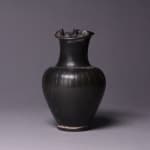Classical Period Black Glazed Oinochoe, 5 Century BCE - 4th Century BCE
Terracotta
17.1 x 10.8 cm
6 3/4 x 4 1/4 in
6 3/4 x 4 1/4 in
CK.0011
Further images
Before the modern advents of trains and automobiles, trade between civilizations concentrated around the Mediterranean moved foremost by sea. While many bulk commodities such as timber and stone could be...
Before the modern advents of trains and automobiles, trade between civilizations concentrated around the Mediterranean moved foremost by sea. While many bulk commodities such as timber and stone could be loaded directly aboard a ship with little preparation, other commodities such as spices, wine, and grain needed to be packed in individual containers for transport both at sea and on land and to prolong their life span. Pottery was first created in order to fulfill these practical needs. Over time, the art form evolved from large, unadorned commercial transport vessels to refined, specialized works in elegant shapes used to hold precious substances such as perfume or oils.
An entire retinue of terracotta vessels dedicated to the rites of the dinner table began to appear. These pieces were based on the luxurious bronze and silver vessels that could only be afforded by the wealthy elite and were decorated with fanciful natural motifs and painted scenes of everyday life and celebrated myths. These wares were of such beauty that they themselves became prized commodities and were traded throughout the Mediterranean world; perhaps even for the very substances they were created to contain. These works are individually classified by their shapes and their form was inherently linked to their function, be it preparation, dispensation, or consumption.
The form of the oinochoe was designed for pouring wine from a krater into a drinking vessel. Covered with a luminous black glaze possessing the sheen and luster of metal, this example has a trefoil mouth and a single handle. The body has been embellished with a series of engraved vertical lines leading from the shoulder to the base. Otherwise, this vessel is completely unadorned.
An entire retinue of terracotta vessels dedicated to the rites of the dinner table began to appear. These pieces were based on the luxurious bronze and silver vessels that could only be afforded by the wealthy elite and were decorated with fanciful natural motifs and painted scenes of everyday life and celebrated myths. These wares were of such beauty that they themselves became prized commodities and were traded throughout the Mediterranean world; perhaps even for the very substances they were created to contain. These works are individually classified by their shapes and their form was inherently linked to their function, be it preparation, dispensation, or consumption.
The form of the oinochoe was designed for pouring wine from a krater into a drinking vessel. Covered with a luminous black glaze possessing the sheen and luster of metal, this example has a trefoil mouth and a single handle. The body has been embellished with a series of engraved vertical lines leading from the shoulder to the base. Otherwise, this vessel is completely unadorned.





